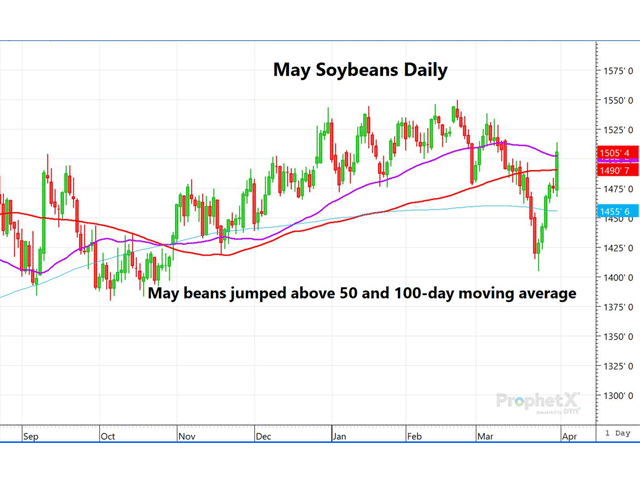USDA Reports Review
Soybean Futures Soar on Lower Stocks and Prospective Plantings
USDA's March 1 Grain Stocks and Prospective Planting reports, released on Friday, March 31, featured lower-than-expected planted acres and March 1 soybean stocks, and higher corn acres (up 4% from last year) than the trade had expected. All wheat planted acres rose by 9% from a year ago, with winter wheat planting up 13% and other spring falling 2%. The report was deemed to be bullish soybeans, bearish new-crop corn and neutral wheat.
CORN
With Dow Jones' pre-report estimates expecting March 1 corn stocks to fall to 7.480 billion bushels (bb), the actual stocks figured about 79 million bushels (mb) lower than that, at 7.40 bb. That was down 5% from a year ago, and total December-to-February usage was pegged at 3.42 bb compared to 3.88 bb a year ago. The corn stocks number was still the lowest in nine years, suggesting higher feed usage. Of the total, 4.11 bb resided on farm, while 3.29 bb was in off-farm storage.
The average pre-report estimate had acres pegged at 90.85 million, and the actual acreage came out nearly 1.2 million acres higher, at 92 million acres (ma) -- that's up 4% or 3.42 million acres from a year ago (88.6 ma). While the acreage number was considered bearish for new-crop corn, December finished just a half-cent lower. May corn futures, trading up 7 cents prior to the report, finished 11 cents higher, closing convincingly above the 50-day moving average for the first time in five weeks.
SOYBEANS
USDA's survey for soybean planting intentions resulted in a nearly unchanged planting intention of 87.5 ma, compared to 87.45 ma one year ago. Pre-report estimates pegged acres planted at 88.23 ma, so the report was considered bullish for new-crop soybeans.
P[L1] D[0x0] M[300x250] OOP[F] ADUNIT[] T[]
March 1 stocks were estimated to be 1.753 bb, and instead fell to just 1.685 bb -- 68 mb less than the trade expected and down 13%, or 247 mb, lower than a year ago, the lowest in six years. The implied disappearance was 1.34 bb in the December-to-February time period, 11% higher than a year ago. With an already very tight ending stocks number of beans (just 210 mb), the nearly 70 mb loss in stocks was construed as very bullish for old-crop soybeans. May soybeans were already close to 19 cents higher before the report was released and rallied to a 31-cent higher close, finishing above both the 50-day and 100-day moving averages.
On-farm stocks were pegged at 750 mb, with off-farm stocks 936 mb.
WHEAT
With the pre-report survey projecting March 1 wheat stocks to fall to just 928 mb, the 946 mb actual stocks number was 83 mb less than last year, and implied higher feeding, with December-to-February usage at 366 mb -- up 5% versus a year ago.
On the acreage front, the focus was on other spring wheat, which, at just under 10.6 ma, was 300,000 acres less than what the trade had expected and down 2% from a year ago. If that 10.57 ma spring wheat number turns out to be correct, it would be the lowest since 1972. Of the "other spring wheat," 9.95 ma figures to be hard red spring.
The biggest surprise came in winter wheat, where the 37.5 ma is up 13% from a year ago, and the number was revised 2% higher from the last report. Hard red winter was pegged at 26 ma, soft red at 7.8 ma and white wheat at 3.71 ma. All wheat planting came out about 1.2 million acres higher than the average trade estimate, at 49.9 ma, up 9% versus a year ago.
Wheat markets finished mixed, with Minneapolis May wheat closing sharply higher on the lower spring plantings, KC up modestly and Chicago finishing unchanged.
CONCLUSION
The 2023 March 1 Grain Stocks and Prospective Planting reports once again spoke to the trend of tightening soybean supplies in the U.S. With an already low ending stocks number, the added usage portrayed in the report is likely to lead to an even tighter carryout. The fact that soybean acres did not increase as much as expected makes U.S. summer weather that much more important. Granted, Brazil is toward the end of a record-large harvest, but Argentina's soy crop, pegged at just 25 million metric tons (918 mb) by the Buenos Aires Exchange, is down 23 mmt (845 mb) from early season projections. That, coupled with the expected rise in renewable biodiesel demand, bodes well for soy product demand and possibly prices.
One thing to keep in mind, acreage intentions are just that, and they are a moving target. Things can change in a short period of time. For now, however, traders were bulled up with Friday's bean numbers.
Dana Mantini can be reached at dana.mantini@dtn.com
Follow him on Twitter @mantini_r
(c) Copyright 2023 DTN, LLC. All rights reserved.






